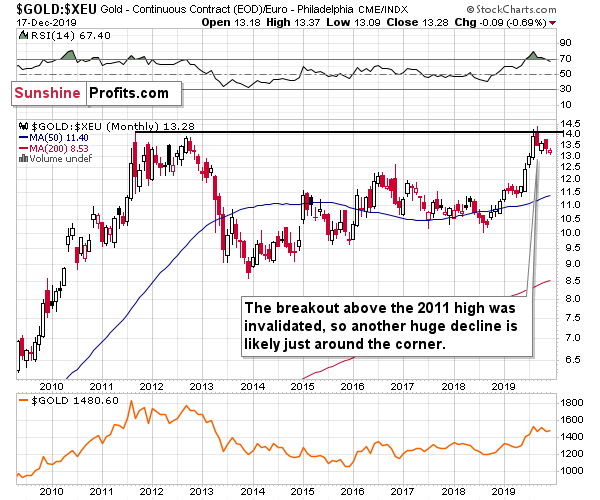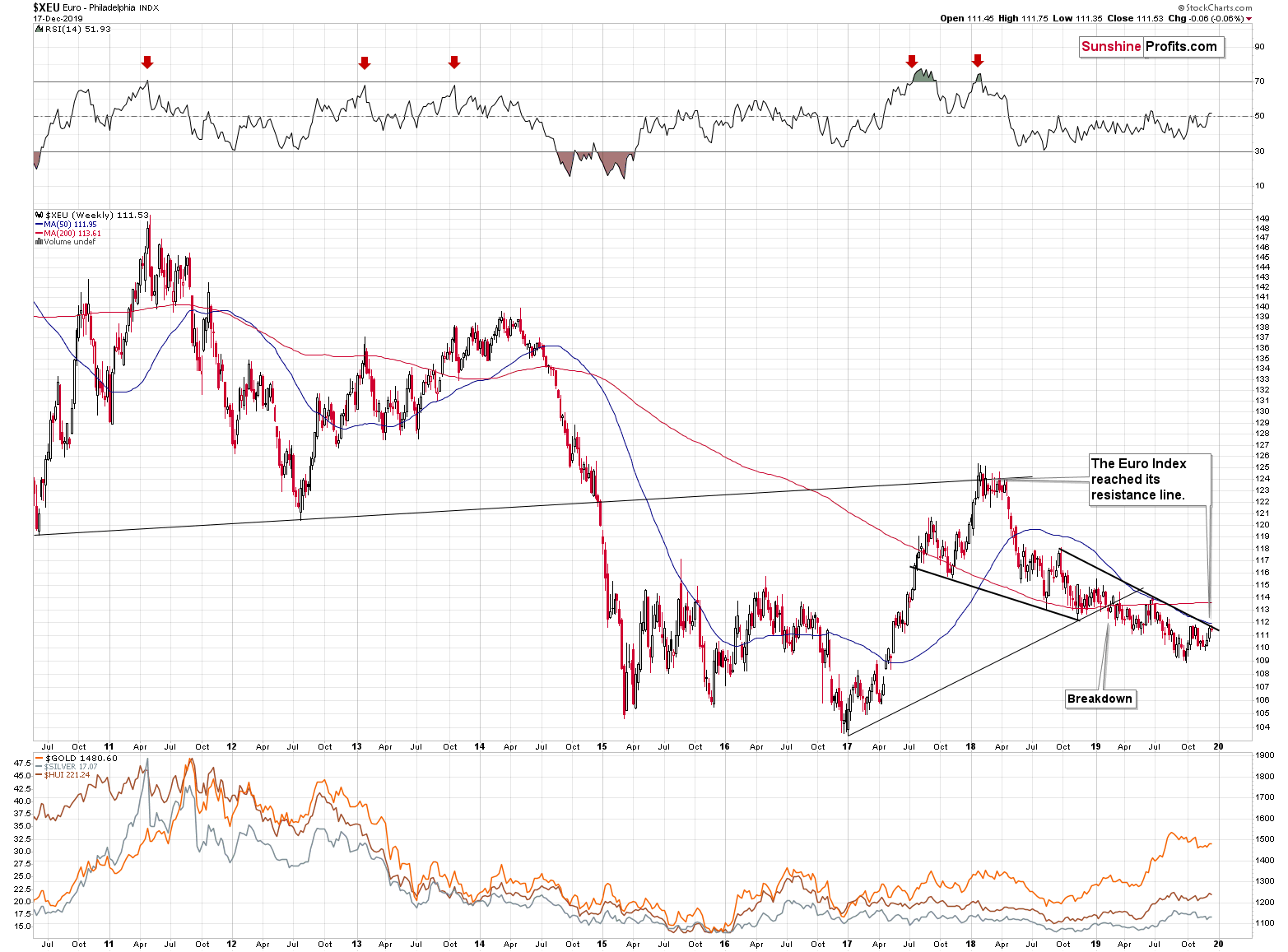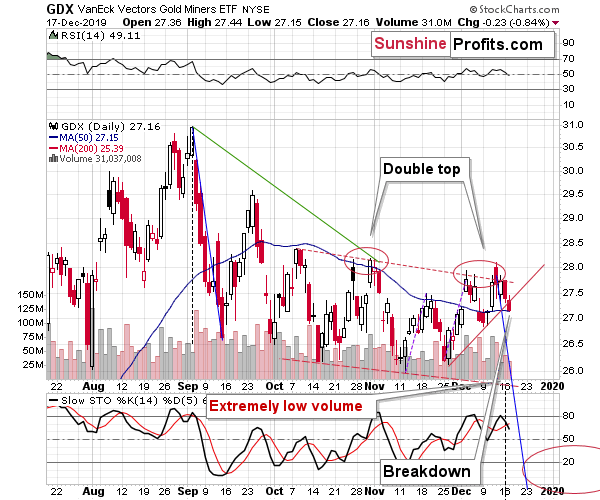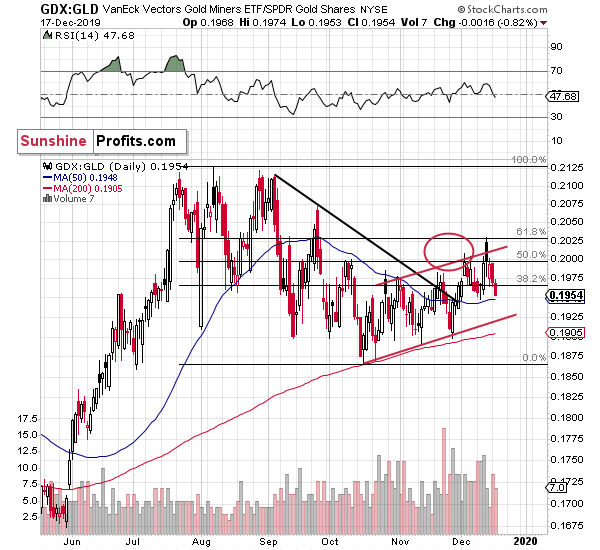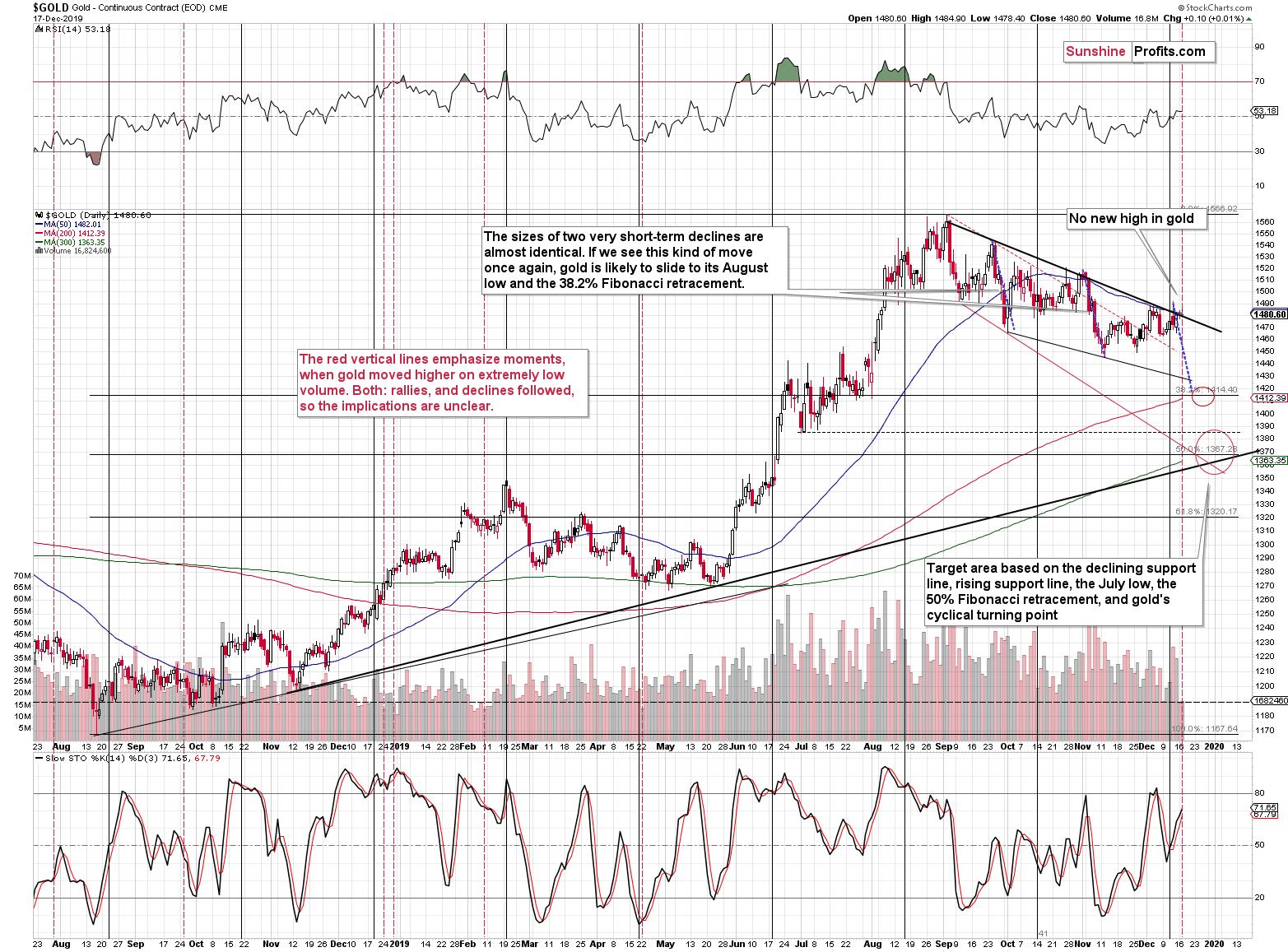Briefly: in our opinion, full (250% of the regular size of the position) speculative short position in gold, silver, and mining stocks is justified from the risk/reward point of view at the moment of publishing this Alert.
Brexit has become very likely due to result of the UK vote. But so what (gold- and currency-wise)? The uncertainty dropped significantly, and markets were able to sign a breath of relief (bearish for gold), but on the other hand Brexit itself increases the geopolitical turmoil (bullish for gold). Gold didn't react decisively in the short run overall, but the European currencies: the euro, and the pound rallied. In the first part of today's analysis, we'll focus on what happened in the euro and how the forex situation fits the other gold price predictions.
Let's start with the long-term chart featuring gold price in terms of the euro.
Gold in the Eyes of the Europeans
The most important thing about gold's performance is it's 2019 attempt to break above the 2011 highs. It succeeded but only for a short while. The breakout was invalidated almost instantly as it was clear that gold is not able to withstand the selling pressure. Invalidations of breakouts tend to be very bearish developments and this time was no exception. And just like that - gold declined.
It's been a few months since gold topped and gold - looking from the long-term perspective - is now only a little lower. Some may say that it's a proof that gold is just correcting after a big rally and that another big upswing is just around the corner. But that's not what the chart facts support. The fact is that gold failed to break above the previous high, which is bearish. Looking at the short-term performance, it might be both: correction or the early part of the decline, but so far nothing happened that would justify the bullish interpretation.
In particular, please note that back in 2012, when gold also tried to break above the previous high (and it actually succeeded in terms of the monthly highs), and failed, it also declined at a relatively slow pace initially. That didn't prevent gold from declining very rapidly in the following months.
This means that if you're using euro for your day-to-day transactions (for instance, because you live in the Western Europe), then you shouldn't count on the continuation in gold's rally in the following months. In fact, something exactly the opposite could take place.
If you're using U.S. dollars for your day-to-day purchases, the above is also very important to you. In this case, the above chart implies that the value of gold is likely to decline relative to what the EUR/USD currency pair will be doing.
And the EUR/USD pair...
The Euro and the Dollar
The Euro Index - proxy for the above - is at its medium-term resistance. Being at an important resistance without breaking above it means that the price is likely to move down. That's how resistances work.
Moreover, please note that the entire September - today decline is one big prolonged shoulder of the bearish head-and-shoulders pattern (the early-2019 rally being the head). This means that once the Euro breaks significantly lower (perhaps triggered by one of the market news scheduled for this week) - below the previous 2019 lows, it's likely to fall particularly hard. The size of the decline that follows the breakdown below the head-and-shoulders pattern is likely to be similar to the size of the head, which in this case means a move below the 2017 low. Of course, this would have major repercussions for many other markets, including gold.
If the euro declines that significantly, breaking below its 2017 low, and at the same time - based on the previous chart - gold declines more than the euro, gold would likely truly plunge in terms of the USD. Of course that's not the only factor that points to this outcome, but it's something that confirms other, even more important factors.
The full version of this analysis isn't just about gold in euro terms though. There, we cover the immediate action in gold, silver and the miners in light of the USD Index twists and turns. Plus, we feature a little known sign that gold's low volume just flashed, and show you its reliability. And of course, you'll also find there the key factors at play and the targets of our promising short position. We encourage you to join our subscribers and reap the rewards. Subscribe today!
While the euro moved to its resistance, the USD Index moved to its support and rebounded higher shortly thereafter.
The USD Index and the PMs Sector
Consequently, what we wrote about the above chart yesterday, remains up-to-date:
The red ellipse that we've been featuring on the above chart was reached. In particular, the USDX moved to its mid-July low and then reversed. It could move lower, to the rising medium-term support line, but it could be the case that the bottom is already in. The latter is more likely as yesterday we saw an invalidation of another attempt to break lower.
Everything that we wrote about the mining stocks and their performance relative to gold remains up-to-date as well:
The thing that we would like to add today is a note about miners' relative performance. They were acting relatively strong in previous days, but the opposite was the case yesterday. Gold closed the day relatively unchanged, and miners declined over 1%.
We saw the same thing once again yesterday. Gold moved up by mere $0.10 and yet miners declined almost 1% instead of moving a bit higher. Let's keep in mind that the general stock market was slightly up yesterday, which means that miners' weakness can't be explained by poor performance of the stock market in general. Miners closed at the fourth lowest close of this month, while gold is trading relatively close to its previous December highs. The miners are clearly underperforming and the new sell signal from the Stochastic indicator serves as yet another bearish confirmation.
In yesterday's Alert, we commented on the miners to gold ratio in the following way:
The target area that we created several weeks ago for the GDX to GLD ratio was reached once again. The ratio between the miners and gold moved to its 61.8% Fibonacci retracement (the upper part of our target area) and then moved lower again. Yesterday's close was the lowest level at which this ratio closed in December. So far, the entire December has been a one big bearish reversal for the ratio.
The decline continued and we saw a new monthly low in terms of the closing prices. The outlook is clearly bearish based on the way miners are performing relative to gold.
There's one thing that we would like to feature today, in order to show you how tricky the signals can be at times.
The Devil Is Hidden in the... Volume
The thing is that gold moved up on volume that we extremely low. This is generally a bearish sign, but... it's not really bearish in case of gold. It works relatively reliably in case of the mining stocks, but as far as gold futures are concerned, one should exercise caution.
Why? Because before one applies any technique to a given market, one should check if it really worked at least in the most recent history. If it did work, then some additional "background checks" should be performed. If this test fails, however, the technique is likely unreliable and thus probably not useful. For instance golden cross and death cross that get financial journalists excited each time they present themselves. They sound cool, grab people's attention and... then they fail to deliver.
Moving back to the volume readings, the vertical red dashed lines show times when the volume in gold was similarly low. We used the horizontal dashed line to make it easier to compare yesterday's volume and previous values.
It turns out that there were cases when the extremely low volume was followed by upswings and there were cases, when it was followed by downswings. In fact, there were more bullish follow-ups than bearish ones. The reliability is not significant enough to view this as a bullish sign, but it's enough to say that this particular sign is currently irrelevant. There are others that one should focus on instead and that's exactly what we do. The above shows you that even if we are not mentioning something in our Alerts in general, it doesn't mean that we are not analyzing it. We are analyzing over 100 charts daily and feature only the selected ones. One of the criteria for including something in the Alerts is that it provides signals that are actually useful. Today is an exception that we included simply because we thought that it's a good example of warning against a misleading signal.
Our subscribers quite often compliment us on the amount of things that we take into account while preparing the analyses - we are grateful for that and while we agree that modesty is a virtue, we would like to reassure you that we are actually considering much more factors than we actually feature.
Naturally, the numerous other factors that we discussed previously continue to support lower precious metals prices in the following months. If you haven't read these analyses - especially the ones from the "critical" section, we strongly encourage you to do so. These are not quick reads, but they are really well worth the time spent reading them.
Key Factors to Keep in Mind
Critical factors:
- The USD Index broke above the very long-term resistance line and verified the breakout above it. Its huge upswing is already underway.
- The USD's long-term upswing is an extremely important and bearish factor for gold. There were only two similar cases in the past few decades, when USD Index was starting profound, long-term bull markets, and they were both accompanied by huge declines in gold and the rest of the precious metals market
- Out of these two similar cases, only one is very similar - the case when gold topped in February 1996. The similarity extends beyond gold's about a yearly delay in reaction to the USD's rally. Also the shape of gold price moves prior to the 1996 high and what we saw in the last couple of years is very similar, which confirm the analysis of the gold-USD link and the above-mentioned implications of USD Index's long-term breakout.
- The similarity between now and 1996 extends to silver and mining stocks - in other words, it goes beyond USD, gold-USD link, and gold itself. The white metal and its miners appear to be in a similar position as well, and the implications are particularly bearish for the miners. After their 1996 top, they erased more than 2/3rds of their prices.
- Many investors got excited by the gold-is-soaring theme in the last few months, but looking beyond the short-term moves, reveals that most of the precious metals sector didn't show substantial strength that would be really visible from the long-term perspective. Gold doesn't appear to be starting a new bull market here, but rather to be an exception from the rule.
- Gold stocks appear to be repeating their performance from 20 years ago, which means that a bottom in the entire precious metals sector is quite likely to form at much lower prices, in about a year
Very important, but not as critical factors:
- Long-term technical signs for silver, i.a. the analogy in terms of price to what we saw in 2008, shows that silver could slide even below $10.
- Silver's very long-term cycles point to a major reversal taking place right now and since the most recent move was up, the implications are bearish (this is also silver's technical sign, but it's so important that it deserves its own point)
- Long-term technical signs for gold stocks point to this not being a new gold bull market beginning. Among others, it's their long-term underperformance relative to gold that hint this is rather a corrective upswing within a bear market that is not over yet.
- Record-breaking weekly volume in gold is a strong sign pointing to lower gold prices
Important factors:
- Extreme volume reading in the SIL ETF (proxy for silver stocks) is an effective indication that lower values of silver miners are to be expected
- Silver's short-term outperformance of gold, and gold stocks' short-term underperformance of gold both confirm that the precious metals sector is topping here
- Gold topped almost right at its cyclical turning point, which makes the trend reversal more likely
- Copper broke below its head-and-shoulders pattern and confirmed the breakdown. The last time we saw something similar was in April 2013, when the entire precious metals sector was on the verge of plunging lower.
Moreover, please note that while there may be a recession threat, it doesn't mean that gold has to rally immediately. Both: recession and gold's multi-year rally could be many months away - comparing what happened to bond yields in the 90s confirms that.
Summary
Summing up, the currency market situation along with the miners' weakness serve as great confirmations of the bearish signs from gold and the bottoming USD Index. The outlook for the precious metals sector remains bearish for the next 1-2 weeks. It's quite likely (no promises, though, as it depends on what the market does) that we're going to take (partial or complete) profits from the current short position this month. We might also reverse the position, but - as above - it's too early to say with certainty at this time. For now, it seems that the USDX is about to rally and the PMs are about to slide.
We have an important announcement.
This week, we are introducing two new services: Market News Reports and Stock Pick Updates. They are both weekly reports: Market News Reports are published early on Mondays, and Stock Pick Updates are published each Wednesday.
There are quite a few free economic calendars available online. Most trading platforms have them. The problem with making use of them is that they often include so much information that it's difficult to really know what to pay attention to. Sometimes there are some "importance" filters there, but it's unclear how one should interpret and use them. It takes both expertise and time to "weed out" the really important info from these calendars.
Different set of news and announcements will be important for those who are investing in the stock market for the long term, and different news are likely to be important for those trading gold in the short term. And different news may be important for those trading crude oil. And so on and so forth. From the long-term investors' point of view, it might be very useful to know that while there are myriads of news that are going to be released in a given week, there's nothing significant enough to likely impact their portfolios. No nail-biting news releases means greater peace of mind and more time to focus on more pleasant non-market activities.
If only someone with experience with all this could segregate the news with regard to the market and one's perspective (investors vs. traders)...
That's exactly what we're doing. Well before the trading starts on Monday, Paul Rejczak is reviewing the upcoming news and creating an easy-to-use Market News Reports where both traders and investors can check which market news are particularly likely to impact their positions in a more meaningful way. We wanted these reports to be accessible for everyone, so they are priced at just $19 per month and there's a 3-week trial for $9.
Now, Stock Pick Updates are probably in tune with what you expect, but also much more than that. There are top 5 candidates for long positions and top 5 candidates for short positions. All 10 carefully selected each week by Paul Rejczak, based on two separate techniques for improved diversification. One technique focuses on choosing the best of the most promising sectors, and the other aims to find the stocks that showed most resilience despite being part of a lagging sector. Both approaches are applied to many sectors and then all stock candidates are reviewed manually, before making it (or not) to our weekly list.
We've been testing both above-mentioned approaches since early October (11 weeks ended since that time) and the total results of their mix was 11.86% gain. During the same time, the S&P 500 gained 10.43%, so the performance of the strategy may not seem that good.... Until one realizes that it was a strategy that was designed to be market neutral as there were just as many long positions as there were short positions. Remember the early-December slide in the S&P? While it declined by 1.66%, our strategy gained 1.53% thanks to profits from the short positions.
During the 11 weeks of tests, there were 8 weeks that were profitable and only 3 that were not.
Looking only at the long candidates and averaging their performance, they gained 13.75% during the time when S&P gained 10.43%. In other words, by selecting stocks with better potential, our long picks gained almost one third more than the stock market in general.
Consequently, regardless if our candidates during the testing period were used as a market neutral strategy, or in order to magnify the gains from long positions, they would have made one very happy with the outcome. Of course, we can't promise any kind of profits or performance - just like no one else in this business can - but we do think that the results achieved week over week justify at least giving this service a try.
We think that the value of this service is greater than that, but - similarly to our profitable Day Trading Signals - we are starting with a relatively low monthly price of $99. We are also starting with a promotion that allows one to subscribe for just $9 for the first 3 weeks.
This means that for just $18 you can enjoy both new services for the next 3 weeks and see if the value they generate is in tune with your expectations. This would also be a perfect time to let us know what you think and what else can we do with regard to both services to make them even better for you. This might also be a good time to consider our All-Inclusive Package, which includes all products that we have and will include all products that we add during one's subscription. You can subscribe to some or all of the above over here.
As always, we'll keep you - our subscribers - informed.
To summarize:
Trading capital (supplementary part of the portfolio; our opinion): Full speculative short position (250% of the full position) in gold, silver, and mining stocks is justified from the risk/reward perspective with the following stop-loss orders and binding exit profit-take price levels:
- Gold futures: profit-take exit price: $1,391; stop-loss: $1,573; initial target price for the DGLD ETN: $36.37; stop-loss for the DGLD ETN: $25.44
- Silver futures: profit-take exit price: $15.11; stop-loss: $19.06; initial target price for the DSLV ETN: $24.88; stop-loss for the DSLV ETN: $14.07
- Mining stocks (price levels for the GDX ETF): profit-take exit price: $23.21; stop-loss: $30.11; initial target price for the DUST ETF: $14.69; stop-loss for the DUST ETF $6.08
In case one wants to bet on junior mining stocks' prices, here are the stop-loss details and target prices:
- GDXJ ETF: profit-take exit price: $30.32; stop-loss: $44.22
- JDST ETF: profit-take exit price: $35.88 stop-loss: $11.68
Long-term capital (core part of the portfolio; our opinion): No positions (in other words: cash)
Insurance capital (core part of the portfolio; our opinion): Full position
Whether you already subscribed or not, we encourage you to find out how to make the most of our alerts and read our replies to the most common alert-and-gold-trading-related-questions.
Please note that the in the trading section we describe the situation for the day that the alert is posted. In other words, it we are writing about a speculative position, it means that it is up-to-date on the day it was posted. We are also featuring the initial target prices, so that you can decide whether keeping a position on a given day is something that is in tune with your approach (some moves are too small for medium-term traders and some might appear too big for day-traders).
Plus, you might want to read why our stop-loss orders are usually relatively far from the current price.
Please note that a full position doesn't mean using all of the capital for a given trade. You will find details on our thoughts on gold portfolio structuring in the Key Insights section on our website.
As a reminder - "initial target price" means exactly that - an "initial" one, it's not a price level at which we suggest closing positions. If this becomes the case (like it did in the previous trade) we will refer to these levels as levels of exit orders (exactly as we've done previously). Stop-loss levels, however, are naturally not "initial", but something that, in our opinion, might be entered as an order.
Since it is impossible to synchronize target prices and stop-loss levels for all the ETFs and ETNs with the main markets that we provide these levels for (gold, silver and mining stocks - the GDX ETF), the stop-loss levels and target prices for other ETNs and ETF (among other: UGLD, DGLD, USLV, DSLV, NUGT, DUST, JNUG, JDST) are provided as supplementary, and not as "final". This means that if a stop-loss or a target level is reached for any of the "additional instruments" (DGLD for instance), but not for the "main instrument" (gold in this case), we will view positions in both gold and DGLD as still open and the stop-loss for DGLD would have to be moved lower. On the other hand, if gold moves to a stop-loss level but DGLD doesn't, then we will view both positions (in gold and DGLD) as closed. In other words, since it's not possible to be 100% certain that each related instrument moves to a given level when the underlying instrument does, we can't provide levels that would be binding. The levels that we do provide are our best estimate of the levels that will correspond to the levels in the underlying assets, but it will be the underlying assets that one will need to focus on regarding the signs pointing to closing a given position or keeping it open. We might adjust the levels in the "additional instruments" without adjusting the levels in the "main instruments", which will simply mean that we have improved our estimation of these levels, not that we changed our outlook on the markets. We are already working on a tool that would update these levels on a daily basis for the most popular ETFs, ETNs and individual mining stocks.
Our preferred ways to invest in and to trade gold along with the reasoning can be found in the how to buy gold section. Additionally, our preferred ETFs and ETNs can be found in our Gold & Silver ETF Ranking.
As a reminder, Gold & Silver Trading Alerts are posted before or on each trading day (we usually post them before the opening bell, but we don't promise doing that each day). If there's anything urgent, we will send you an additional small alert before posting the main one.
Thank you.
Sincerely,
Przemyslaw Radomski, CFA
Editor-in-chief, Gold & Silver Fund Manager


